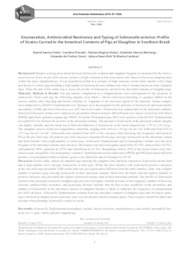Enumeration, antimicrobial resistance and typing of salmonella enterica: profile of strains carried in the intestinal contents of pigs at slaughter in southern Brazil.
Enumeration, antimicrobial resistance and typing of salmonella enterica: profile of strains carried in the intestinal contents of pigs at slaughter in southern Brazil.
Author(s): PAIM, D. S.; PISSETTI, C.; VIEIRA, T. R.; WERLANG, G. O.; COSTA, E. de F.; KICH, J. D.; CARDOSO, M. R. de I.
Summary: ABSTRACT: Background: Despite a strong association between Salmonella isolation and slaughter hygiene, as measured by the Enterobacteriaceae levels on pre-chill carcass surfaces, a high variation in this association was observed between sampling days within the same slaughterhouse. It was hypothesised that in a scenario of high exposure on the farm, batches with a high prevalence of carrier pigs shedding a high number of Salmonella may enhance the risk of contamination on some slaughter days. Thus, the aim of this study was to assess the profile of Salmonella carried in the intestinal contents of slaughter pigs. Materials, Methods & Results: Ten pig batches slaughtered in a slaughterhouse were investigated for the presence of Salmonella. From each pig, the following samples were taken: i. blood collected at bleeding; ii. sponges rubbed on the carcass surface after bleeding and before chilling; iii. fragment of the ileocecal region of the intestine. Serum samples were subjected to a ELISA-Typhimurium test. Sponges were investigated for the presence of Salmonella and total aerobic mesophilic (TAM) and terobacteriaceae (EC) bacterial counts. Salmonella was enumerated in the intestinal contents. Selected Salmonella strains were subjected to an antimicrobial resistance disk diffusion test, macro-restriction with Xba-I (PFGE) and whole genome sequencing (WGS). From the 50 sampled pigs, 96% were positive in the ELISA-Typhimurium test and 64% were Salmonella-positive in the intestinal contents. The amount of Salmonella in the intestinal content samples was highly variable, and the mean log of fitted distributions of Salmonella in the batch ranged from -2.97 to 2.25 cfu.g-1. The slaughter process achieved a logarithmic reduction, ranging from 0.64 to 2.35 log cfu.cm-2 for TAM and from 0.55 to 2.57 log cfu.cm-2 for EC. Salmonella was isolated from 16% of the carcasses after bleeding; this frequency decreased to 8% at the pre-chill step. All positive pre-chill carcasses originated from pigs carrying Salmonella in the intestinal content and from batches with a high number of carrier pigs. Salmonella Typhimurium and its monophasic variant were the most frequent in the intestinal contents and carcasses. Resistance was detected against ampicillin (42.5%), tetracycline (42.5%), sulfonamide (40%), gentamicin (25%) and ciprofloxacin (12.5%). Regarding colistin, 85% of the tested strains were classified as non-susceptible. The monophasic variant S. Typhimurium strains subjected to PFGE and WGS presented different profiles; several antimicrobial resistance genes were identified and all belonged to ST-19. Discussion: In this study, almost all sampled pigs entering the slaughter line had been exposed to Salmonella on the farm and a high number were carrying Salmonella in their guts. While the three batches with Salmonella-positive carcasses at the pre-chill step presented TAM media that was not significantly different from the other batches, there was a higher number of positive pigs carrying Salmonella in their intestinal contents. Moreover, the batch with the highest number of positive carcasses also presented the highest Salmonella mean count in their intestinal contents. The profile of Salmonella carried in the intestinal content of slaughter pigs proved to be highly variable in terms of the frequency, number of bacteria, serovars, antimicrobial resistance, and genotypes. Results indicate that the day-to-day variability in the prevalence and number of Salmonella in the intestinal contents of slaughter batches is likely to influence the frequency of contaminated pre-chill carcasses. Salmonella Typhimurium isolated from the intestinal contents of slaughter pigs may belong to genotypes involved in human disease and may carry several antimicrobial resistance genes. These aspects should be taken into account when planning Salmonella control in swine.
Publication year: 2019
Types of publication: Journal article
Unit: Embrapa Swine & Poultry
Observation
Some of Embrapa's publications are published as ePub files. To read them, use or download one of the following free software options to your computer or mobile device. Android: Google Play Books; IOS: iBooks; Windows and Linux: Calibre.
Access other publications
Access the Agricultural Research Database (BDPA) to consult Embrapa's full library collection and records.
Visit Embrapa Bookstore to purchase books and other publications sold by Embrapa.

